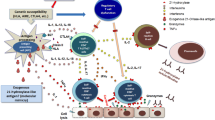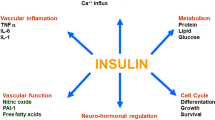Abstract
Background
Subclinical hypercortisolism (SH) has been associated with metabolic complications such as type 2 diabetes mellitus, obesity and dyslipidemia. Scarce data are available regarding the lipid pattern abnormalities in SH, in relation to insulin resistance and impaired glucose metabolism (IGM). We aimed to evaluate the possible influence of SH on lipid pattern in relation to the presence/absence of impaired glucose metabolism.
Methods
In 338 patients with adrenal incidentaloma, the presence of SH, hypertension, dyslipidemia and IGM was evaluated. According to the presence of SH and IGM the patients were divided into 4 groups (IGM+SH+, IGM+SH−, IGM−SH+, IGM−SH−). We recruited 98 subjects without IGM (IGM-) and 100 with IGM (IGM+) as control groups.
Results
The prevalence of dyslipidemia was comparable among Group IGM+SH+, Group IGM+SH− and IGM+ controls (57.9, 58.4, 56 %, P = NS). No difference in dyslipidemia prevalence among IGM− patients and IGM− controls was observed. The IGM+SH+ patients had a higher prevalence of dyslipidemia (57.9 %) than IGM−SH+ ones (29.1 %, P < 0.01). The IGM+SH− patients showed an increased prevalence of hypertension (76.6 vs 54.8 %, P < 0.01) and dyslipidemia (58.4 vs 23.8 %, P < 0.0001) as compared with IGM−SH− patients. Logistic regression analysis showed that only IGM was associated to dyslipidemia (OR 4.31, 95 % CI 2.61–7.12, P = 0.0001) regardless of age, SH and gender.
Conclusions
In the absence of alterations of glucose metabolism the presence of a subtle cortisol excess has no effect on lipid pattern. IGM seems to influence the lipid metabolism regardless of the presence of SH.
Similar content being viewed by others
References
Ross NS, Aron DC (1990) Hormonal evaluation of the patient with an incidentally discovered adrenal mass. NEJM 323(20):1401–1405
Kloos RT, Gros MD, Francis IR, Korobkin M, Shapiro B (1995) Incidentally discovered adrenal masses. Endocr Rev 16(4):460–484
Barzon L, Sonino N, Fallo F, Palu G, Boscaro M (2003) Prevalence and natural history of adrenal incidentalomas. Eur J Endocrinol 149(4):273–285
Singh PK, Buch HN (2008) Adrenal incidentaloma: evaluation and management. J Clin Pathol 61(11):1168–1173. doi:10.1136/jcp.2006.044313
Mantero F, Terzolo M, Arnaldi G, Osella G, Masini AM, Alì A, Giovagnetti M, Opocher G, Angeli A (2000) A survey on adrenal incidentaloma in Italy. Study Group on Adrenal Tumors of the Italian Society of Endocrinology. J Clin Endocrinol Metab 85(2):637–644
Reincke M, Nieke J, Krestin GP, Saeger W, Allolio B, Winkelmann W (2002) Preclinical Cushing’s syndrome in adrenal incidentalomas: comparison with adrenal Cushing’s syndrome. J Clin Endocrinol Metab 75(3):826–832
Tsagarakis S, Vassiliadi D, Thalassinos N (2006) Endogenous Subclinical hypercortisolism: diagnostic uncertainties and clinical implications. J Endocrinol Invest 29(5):471–482
Chiodini I, Guglielmi G, Battista C, Carnevale V, Torlontano M, Cammisa M, Trischitta V, Scillitani A (2004) Spinal volumetric bone mineral density and vertebral fractures in female patients with adrenal incidentalomas: the effects of subclinical hypercortisolism and gonadal status. J Clin Endocrinol Metab 89(5):2237–2241
Chiodini I, Mascia ML, Muscarella S, Battista C, Minisola S, Arosio M, Santini SA, Guglielmi G, Carnevale V, Scillitani A (2007) Subclinical hypercortisolism among outpatients referred for osteoporosis. Ann Intern Med 147(8):541–548
Chiodini I, Torlontano M, Scillitani A, Arosio M, Bacci S, Di Lembo S, Epaminonda P, Augello G, Enrini R, Ambrosi B, Adda G, Trischitta V (2005) Association of subclinical hypercortisolism with type 2 diabetes mellitus: a case-control study in hospitalized patients. Eur J Endocrinol 153(6):837–844
Chiodini I, Morelli V, Masserini B, Salcuni AS, Eller-Vainicher C, Viti R, Coletti F, Guglielmi G, Battista C, Carnevale V, Iorio L, Beck-Peccoz P, Arosio M, Ambrosi B, Scillitani A (2009) Bone mineral density, prevalence of vertebral fractures and bone quality in patients with adrenal incidentalomas with and without subclinical hypercortisolism: an Italian Multicenter Study. J Clin Endocrinol Metab 94(9):3207–3214. doi:10.1210/jc.2009-0468
Terzolo M, Pia A, Alì A, Osella G, Reimondo G, Bovio S, Daffara F, Procopio M, Paccotti P, Borretta G, Angeli A (2002) Adrenal incidentaloma: a new cause of the metabolic syndrome? J Clin Endocrinol Metab 87(3):998–1003
Fernández-Real JM, Engel WR, Simó R, Salinas I, Webb SM (1998) Study of glucose tolerance in consecutive patients harbouring incidental adrenal tumours. Study Group of Incidental Adrenal Adenoma. Clin Endocrinol 49(1):53–61
Tauchmanovà L, Rossi R, Biondi B, Pulcrano M, Nuzzo V, Palmieri EA, Fazio S, Lombardi G (2002) Patients with subclinical Cushing’s syndrome due to adrenal adenoma have increased cardiovascular risk. J Clin Endocrinol Metab 87(11):4872–4878
Chiodini I (2011) Clinical review: diagnosis and treatment of subclinical hypercortisolism. J Clin Endocrinol Metab 96(5):1223–1236. doi:10.1210/jc.2010-2722
Rossi R, Tauchmanova L, Luciano A, Di Martino M, Battista C, Del Viscovo L, Nuzzo V, Lombardi G (2000) Subclinical Cushing’s syndrome in patients with adrenal incidentaloma: clinical and biochemical features. J Clin Endocrinol Metab 85(4):1440–1448
Ginsberg HN (2006) Efficacy and mechanism of action of statins in the treatment of diabetic dyslipidemia. J Clin Endocrinol Metab 91(2):383–392
Arnaldi G, Scandali VM, Trementino L, Cardinaletti M, Appolloni G, Boscaro M (2010) Pathophysiology of dyslipidemia in Cushing’s syndrome. Neuroendocrinology 92(Suppl 1):86–90. doi:10.1159/000314213
van Raalte DH, Ouwens DM, Diamant M (2009) Novel insights into glucocorticoid-mediated diabetogenic effects: towards expansion of therapeutic options? Eur J Clin Invest 39(2):81–93. doi:10.1111/j.1365-2362.2008.02067.x
Mullugeta Yonas, Chawla Rajinder, Kebede Tedla, Worku Yesehak (2012) Dyslipidemia associated with poor glycemic control in type 2 diabetes mellitus and the protective effect of metformin supplementation. Indian J Clin Biochem 27(4):363–369
Gatti A, Maranghi M, Bacci S, Carallo C, Gnasso A, Mandosi E, Fallarino M, Morano S, Trischitta V, Filetti S (2009) Poor glycemic control is an independent risk factor for low HDL cholesterol in patients with type 2 diabetes. Diabetes Care 32(8):1550–1552. doi:10.2337/dc09-0256
Expert Panel on Detection, Evaluation, and Treatment of High Blood Cholesterol in Adults (2001) Executive summary of the third report of The National Cholesterol Education Program (NCEP) Expert Panel on detection, evaluation, and treatment of high blood cholesterol in adults (adult treatment panel III). JAMA 285(19):2486–2497
American Diabetes Association (2009) Diagnosis and classification of diabetes mellitus. Diabetes Care 32(Suppl 1):S62–S67. doi:10.2337/dc09-S062
Mancia G, De Backer G, Dominiczak A, Cifkova R, Fagard R, Germano G, Grassi G, Heagerty AM, Kjeldsen SE, Laurent S, Narkiewicz K, Ruilope L, Rynkiewicz A, Schmieder RE, Boudier HA, Zanchetti A; ESH-ESC Task Force on the Management of Arterial Hypertension (2007) 2007 ESH-ESC practice guidelines for the management of arterial hypertension: ESH-ESC task force on the management of arterial hypertension. J Hypertens 25(9):1751–1762
Matthews DR, Hosker JP, Rudenski AS, Naylor BA, Treacher DF, Turner RC (1985) Homeostasis model assessment insulin resistance and beta cell function from fasting plasma glucose and insulin concentrations in man. Diabetologia 28(7):412–441
Morelli V, Reimondo G, Giordano R, Della Casa S, Policola C, Palmieri S, Salcuni AS, Dolci A, Mendola M, Arosio M, Ambrosi B, Scillitani A, Ghigo E, Beck-Peccoz P, Terzolo M, Chiodini I (2014) Long-term follow-up in adrenal incidentalomas: an Italian Multicenter Study. J Clin Endocrinol Metab 99(3):827–834
Conflict of interest
The authors have nothing to declare.
Author information
Authors and Affiliations
Corresponding author
Rights and permissions
About this article
Cite this article
Masserini, B., Morelli, V., Palmieri, S. et al. Lipid abnormalities in patients with adrenal incidentalomas: role of subclinical hypercortisolism and impaired glucose metabolism. J Endocrinol Invest 38, 623–628 (2015). https://doi.org/10.1007/s40618-014-0232-0
Received:
Accepted:
Published:
Issue Date:
DOI: https://doi.org/10.1007/s40618-014-0232-0




